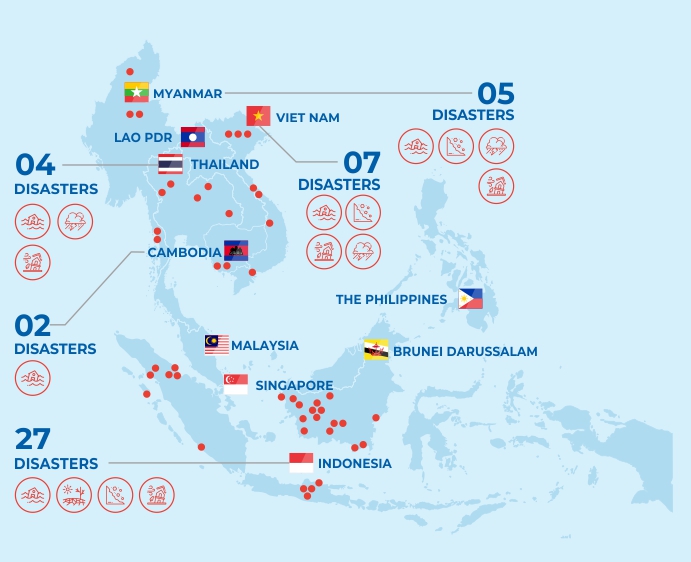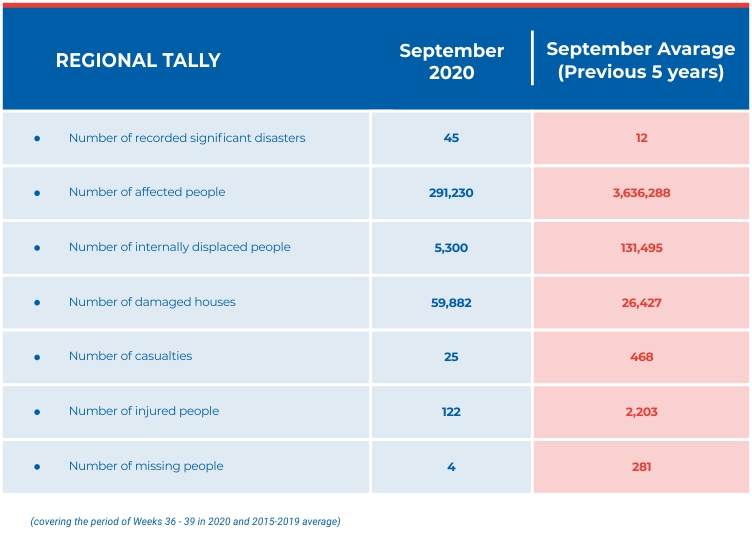
MONTHLY DISASTER REVIEW AND OUTLOOK
SEPTEMBER 2020 | DISASTER MONITORING & ANALYSIS
(DMA) UNIT, AHA CENTRE
GENERAL REVIEW OF SEPTEMBER 2020
A total of 45 disaster events were recorded for the month of September 2020, which 1 1/2 times higher than August 2020, and is almost four times the five-year average for September. Despite this increase, there were a range of lower numbers compared to five-year averages, including significantly less people affected, internally displaced, casualties and injuries. There were more houses damaged, however, than the average. These significant differences can be attributed to severe disaster events taking place in September 2018, including the earthquake and tsunami in Central Sulawesi, an earthquake in the Philippines, and Typhoon Mangkhut which affected the northern part of the Philippines, Malaysia, and Viet Nam. In total, said events affected about 10 million people in 2018. Additionally, 2017 saw massive droughts in Indonesia, which affected around 4 million people, and also contributes to the high five-year average figures for the month of September.
A total of 27 significant earthquakes (M≥5.0) were reported in the region for September 2020, and also ongoing volcanic activity reported for the Indonesian mountains of Anak Krakatau, Ibu, Semeru, and Dukono. While the events did not result in significant damage, they do serve as a timely reminder of the importance of geophysical hazard preparedness, particularly in tectonically active countries like Indonesia and the Philippines.
SEASONAL OUTLOOK
Southwest monsoon conditions are expected to persist throughout October 2020, before gradually transitioning into the inter-monsoon period in the latter part of the month. Inter-monsoon conditions are characterised by light and variable winds, with rainy conditions expected over most of the ASEAN region. The inter-monsoon period typically lasts for about a month before the onset of Northeast Monsoon conditions, when the northern ASEAN region enters its traditional dry season, while the southern ASEAN region experiences increased rainfall.
For the October to December period, models predict above-normal rainfall over much of the Maritime Continent (south of the equator and the Philippines) and coastal regions of Viet Nam. La Niña conditions have developed over the tropical Pacific Ocean, and most climate models predict La Niña will bring wetter-than-normal conditions over the Southeast Asia region. These are expected to persist for October through to December 2020, which may cause more torrential rains and resulting flooding across many areas.
While warmer-than-normal temperatures are expected to continue over much of the Maritime Continent for the next three months, parts of Viet Nam, Laos, Cambodia and Thailand may experience below to near-normal temperatures.
For October and November, hotspot activities in the ASEAN region are expected to remain generally subdued due to rainy weather, although isolated hotspots may be detected in some areas during brief periods of drier weather. In December 2020, a gradual increase in hotspot activities may be expected in the northern ASEAN region as it enters its traditional dry season with the onset of Northeast Monsoon.
Data Sources: ASEAN Disaster Information Network, ASEAN Specialised Meteorological Centre
Written by : Keith Paolo Landicho, Lawrence Anthony Dimailig, Aril Aditian
DISCLAIMER
Disclaimer: AHA Centre’s estimation is based on data and information shared by National Disaster Management Organisations (NDMOs) and other relevant agencies from ASEAN Member States, international organisations and news agencies. Further information on each recorded-significant disaster, description and detail of data and information are available at: http://adinet.ahacentre.org/reports.



